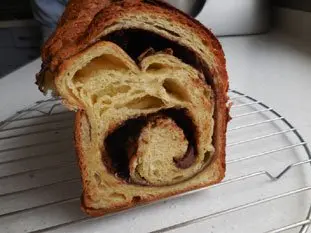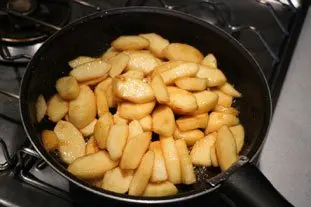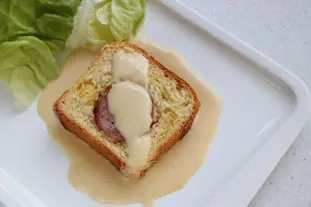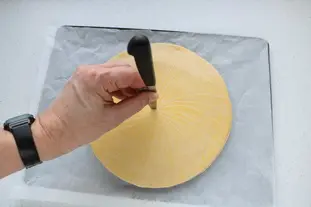The "caves" in the bakery and pastry shop

Maybe you've already done this? You want to make a brioche or a cake with fruit inside, you decide to proceed with your usual recipe, but also to add in the dough pieces of fresh and raw fruit, or whole fruit, for example pieces of apples or pears, good idea.
When you bake it, everything seems to go well, you may notice that it puffs up more than usual, but nothing to worry about, on the contrary it's quite good news.
It's only when you cut it that you discover the problem, the pieces of fruit are not surrounded by dough, they are in a kind of cavity of the dough, much bigger than them, and so it's quite ugly all this empty space around, and moreover not very pleasant to taste.
When you bake it, everything seems to go well, you may notice that it puffs up more than usual, but nothing to worry about, on the contrary it's quite good news.
It's only when you cut it that you discover the problem, the pieces of fruit are not surrounded by dough, they are in a kind of cavity of the dough, much bigger than them, and so it's quite ugly all this empty space around, and moreover not very pleasant to taste.
12 K 4.9/5 (17 reviews)
Keywords for this post:PastryBakingCookingBreadCakeHollowBubblesHolesCaveLast modified on: March 27th 2021
The "caves" in the bakery and pastry shop
What happened?
It's very simple, you have intuitively added pieces of fresh and raw fruit which contain a lot of water. During the baking process, this water was transformed into steam by the heat, and this steam, which can't get out, pushed the not yet baked dough, therefore soft, around each piece of fruit, and formed this hollow that the bakers call "cavern". Once the dough is cooked, the cavern remains in place, even when cooling, and therefore gives this unsightly aspect.It happens as soon as you add something containing water to a dough, and it is much more pronounced when it is a leavened dough (brioche, bread, because of or thanks to the gluten network) or flaky dough, and much less on travel cakes (cake, cookies, ...) easier to steam through.
This also applies to salted food for example for a sausage in brioche you would have the same problem.

How to avoid this?
There are basically 2 solutions: Either you remove/reduce the water in the first place, or you do something to allow the cooking steam to escape.Removing the water, or at least reducing it is quite simple, for fresh fruit for example we cook them slightly before. For example for apples and pears, in a little butter and sugar, you can even caramelize them, which gives a whole new (delicious) taste to your cake.

For a sausage, same treatment, either you cook it in the oven, or you poach it before incorporating it.
This is the secret of very aesthetic brioche sausages.

For a galette des rois for example, it is about 2 discs of puff pastry with cream in the middle, we pierce a small hole, the chimney in the center of the galette to allow the steam to escape. Without this chimney you will have in the oven a kind of huge puff pastry bell, and full of emptiness.

It should be noted that for all this, we are more on a question of aesthetics and mouthfeel, the taste is not impacted.
In summary: To avoid cavities in your cakes, reduce the water brought by your inserts, or provide an outlet for the steam generated during baking.
Lasts posts
Butter vs. grease
We often read in a recipe where a pastry is put into a mould that, just before pouring, the mould should be buttered or greased. But what's the difference between these 2 terms?December 1st 20254925
Getting out of the fridge early
Very often when you're cooking, you need to take food or preparations out of the fridge, to use them in the recipe in progress. There's nothing tricky about this: you just take them out of the fridge and use them, usually immediately, in the recipe. But is this really a good method?November 24th 20258995
Who's making the croissants?
When you look at a bakery from the outside, you naturally think that in the bakery, the bakers make the bread, and in the laboratory, the pastry chefs make the cakes. It's very often like that, with each of these professions having quite different ways of working, but sometimes there's also one...November 23th 2025798
Oven height
When we put a dish or cake in the oven, we naturally tend to put it on the middle shelf, and that's what we usually do. But in some cases, this position and height can be a little tricky, so let's find out why.October 8th 20252,3785
The importance of sieving
In recipes that use a fine powder (flour, powdered sugar, etc.), you'll often see the advice to sift before using it. To sift is to pass the powder in question through a sieve (a very fine strainer) before incorporating it into your recipe. It's often advice, but is it really useful?September 3rd 20257,3053
Other pages you may also like
Perpetual stock
It's something you have probably have done yourself: cooked or pre-cooked vegetables before adding them to a recipe. This is almost always done the same way: peel the chosen vegetables (carrots, for example), cut them up, boil them in salted water (using a tablespoon or so of coarse salt per litre),...November 22th 201631 K5
Candied fruits: don't get ripped off
Do you like candied fruit? You might like to nibble a handful or add it to a recipe, like a classic fruit cake or delicious Italian specialities like panettone or sicilian epiphany pie.June 21th 201767 K 24.2
For well opened (puffed) cakes
It's always nice to have a well puffed up cake after baking, not only will it taste good but it looks great too. Let's see how to get this beautiful shape almost every time.January 23th 201935 K4.2
Baking cakes
Where we see that to put a cake in the oven, once the dough is finished and in its mould, there is no hurry and that the cold is your friend.June 28th 201945 K4.1
How to break eggs properly?
It is a very common gesture in pastry, bakery and of course cooking: breaking eggs to incorporate them into a recipe. You have eggs (which professionals call "shell eggs" to differentiate them from liquid eggs in cartons or cans), and you must break them to incorporate the contents into your...June 26th 202115 K4.8
Post a comment or question
Follow this page (as 2 people already do)
If you are interested in this page, you can "follow" it, by entering your email address here. You will then receive a notification immediately each time the page is modified or a new comment is added. Please note that you will need to confirm this following.
Note: We'll never share your e-mail address with anyone else.
Alternatively: you can subscribe to the mailing list of cooling-ez.com , you will receive a e-mail for each new recipe published on the site.









